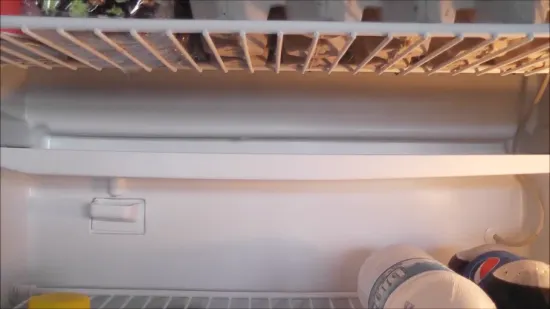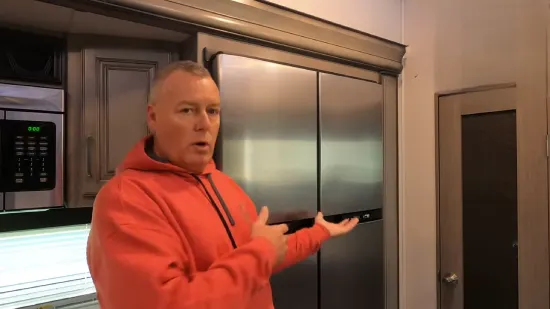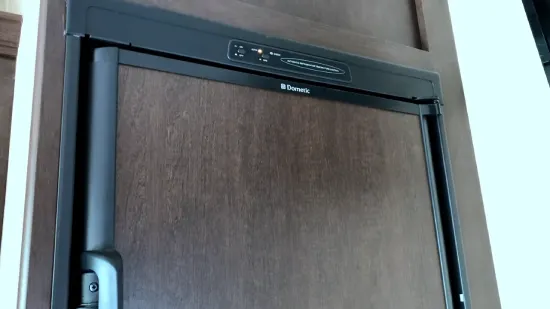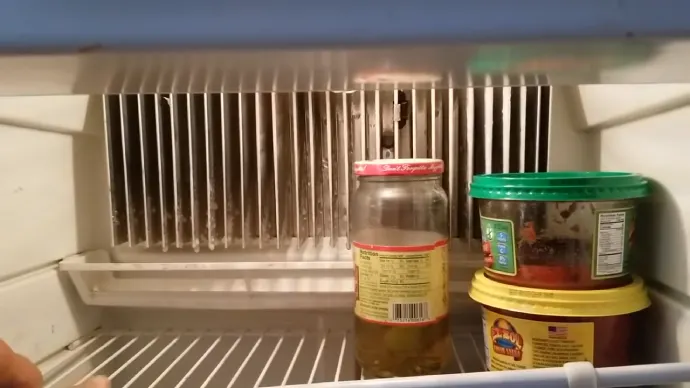Last Updated on September 19, 2023
A leaking RV fridge is often a sign of problems. If you need clarification on why your RV fridge is dripping water, there are a few potential causes to consider.
One of the main causes of dripping water is a clogged drain line, resulting in water buildup and overflow from the drip pan. The loose end of the drain line could be responsible for the leak. Also, the issue may lie with the plastic fittings that could crack and cause water to escape.
Let’s figure out why your RV fridge is leaking water in detail. We’ll break it down so you have all the answers and can take the appropriate steps to resolve it.
Why Is the RV Fridge Dripping Water: Understand the Reasons

Your RV fridge may be leaking water for a variety of reasons. The following is a brief overview:
1. Clogged Drain Line
2. Loose End of the Drain Line
3. Plastic Fittings
4. Cracked Drip Pan
5. Improper Leveling
6. Condensation
7. Damaged Door Gasket
Now let’s take a closer look:
1. Clogged Drain Line
A clogged drain line is one of the key reasons why an RV fridge may be dripping water. This can be attributed to the accumulation of food particles, ice, and other debris in the drain line, which can clog it.
The drain line directs water outside the fridge during defrosting or when condensation occurs. When it is blocked, this water cannot flow out properly, leading to water building up inside the fridge and eventually causing leakage.
2. Loose End of the Drain Line
When the end of the drain line is not securely attached to the drain pan or the collection tray, water can drip inside the RV fridge instead of being directed outside. This can lead to water leakage inside the fridge.
To avoid water leakage due to this issue, it is essential to ensure that the drain line is securely connected to the drain pan or tray.
3. Plastic Fittings
Another cause of RV fridge water leakage is plastic fittings that connect the drain line to the drain pan or collection tray.
Water pressure or movement during travel can sometimes cause these fittings to pop off, leading to water leaking inside the fridge.
Checking the fittings for tightness and proper connection can help prevent this issue and ensure proper water routing.
4. Cracked Drip Pan
In certain RV refrigerators, a drip pan located beneath the cooling unit collects condensation and defrost water. If this drip pan is cracked or damaged, it can cause water to leak inside the fridge instead of being contained.
This could happen due to wear and tear, a heavy impact, or improper installation. Inspecting the drip pan for any signs of cracks or leakage is essential to prevent water from dripping inside the fridge.
5. Improper Leveling
When your RV is not level, the water may not flow as intended, leading to leaks or pooling inside the refrigerator. This can result from various factors, such as parking on an uneven surface or not using leveling blocks.
Proper leveling can be achieved by using leveling blocks under the wheels of your RV or by adjusting the jacks.
You need to check the level of your RV before setting up camp and periodically during your stay. If your RV is not level, make the necessary adjustments to avoid any potential problems with your refrigerator and other appliances.
6. Condensation
Condensation is another common cause of water dripping from RV fridges. When warm air enters the refrigerator compartment, it comes into contact with the cold surfaces, leading to water droplets forming on the interior shelves and other fridge surfaces.
Humidity is also a factor, especially in areas with high humidity levels. When there is excessive moisture in the air, it can cause water to collect in the fridge, leading to dripping. Also, frequently opening the fridge door can introduce humid air, which can condense on the refrigerators’ cold surfaces.
7. Damaged Door Gasket
Another reason why your RV fridge might be dripping water is a damaged door gasket. The door gasket is a rubber seal that creates an airtight barrier between the fridge and the surrounding environment. If there is a tear or worn spot in the gasket, warm, humid air can penetrate the fridge compartment.
With this damage, the fridge is forced to work harder to maintain a cool temperature, creating condensation on the inside. This, in turn, leads to water dripping. Checking your fridge’s gasket for any possible damage is essential.
What Steps Can You Take to Prevent Water From Dripping Inside Your RV Refrigerator?

You can take several steps to keep your RV refrigerator from dripping. Here’s what you need to do:
1. Check the RV fridge Door Seals
Ensure your RV fridge door seals are in good condition and create a tight seal, as worn or damaged seals can cause air and moisture leaks, leading to water dripping from the fridge. Here’s how to check your door seals:
- Close the fridge door and try to slide a piece of paper between the seal and the fridge. If the paper easily slides in, it may be time to replace the seal.
- Inspect the seals for any cracks or gaps. Even small cracks can lead to leaks.
- Clean the seals regularly with mild soap and water to prevent any buildup that may damage them.
- Consider using a seal lubricant to keep the seals pliable and prevent them from drying out and cracking.
2. Level Your RV
If your RV isn’t properly leveled, the cooling system may malfunction, resulting in condensation and a dripping fridge.
A bubble level will help you level your RV from side to side and front to back. Start by parking your RV on a level surface.
Then, place the bubble level on the floor of your RV and adjust the leveling jacks until the bubble is centered. Repeat this process for the front and back of your RV.
Once your RV is level, the cooling system in your fridge should function properly, preventing condensation and water buildup.
Remember to monitor the level of your RV periodically, especially after moving it, to ensure it remains level and your fridge is working efficiently.
3. Avoid Overfilling
If you cram too much into your fridge, it’s like trying to fit a square peg into a round hole. The airflow will be obstructed and you’ll end up with a hot mess.
This can cause temperature imbalances, leading to condensation and water dripping from your RV fridge. To avoid this, ensure adequate space for air circulation inside the refrigerator.
Overfilling your RV fridge causes condensation and water dripping and limits the fridge’s cooling efficiency.
When there is not enough space for air to circulate, the fridge’s compressor has to work harder to cool everything down, leading to higher energy consumption and a shorter lifespan for your fridge.
So, avoid overfilling your fridge and allow proper air circulation to keep your RV fridge running efficiently.
4. Monitor Temperature Settings
Monitoring temperature settings is crucial to prevent condensation and ensure your food stays fresh and cool in the refrigerator of your RV. Be sure that the temperature settings are appropriate for the contents being stored.
If the temperature inside the refrigerator is too low, it can cause condensation on the walls and shelves, leading to dripping water and even spoilage of your food.
On the other hand, if the temperature is too high, your food may not be stored at a safe temperature, leading to potential health risks.
Is it normal for my RV refrigerator to produce a small amount of water inside?
It is normal for RV refrigerators to generate a small amount of water due to the defrosting process and condensation. This is because the refrigerator removes heat and moisture from the unit’s interior.
As it cools the air inside, the moisture condenses on the cooling coils and eventually drips into a drain pan. The small amount of water that results from this process is typically harmless.
But, if you notice excessive water buildup or noticeable leakage, it may be a sign of a more serious problem, such as a clogged drain or faulty seal. In these cases, you need to investigate the issue further to prevent damage to your RV and its contents.
What temperature range should your RV refrigerator set to prevent water from dripping inside?

To prevent water dripping inside your RV refrigerator, it is recommended to set the temperature between 34°F to 40°F (1°C to 4°C).
This particular temperature range is an ideal environment that maintains a cool but not excessively cold temperature. That way, condensation, water buildup, and dripping will be less likely to occur.
But referring to your RV refrigerator’s manual for any manufacturer-recommended temperature settings or adjustments based on your model’s specifications is always advisable.
Following this simple guideline will ensure that your RV refrigerator functions optimally, keeping your food and drinks cool and fresh.
Can opening the RV fridge frequently cause water to drip inside?
Frequent opening of the RV fridge can introduce warm air, leading to increased condensation. But, this should not typically result in significant water dripping inside, provided that the drainage system is functioning correctly.
It’s crucial to ensure that the fridge’s door seal is in good condition, as a damaged seal may increase moisture levels.
To prevent excess moisture buildup, it is advisable to use a dehumidifier in the RV, especially during humid conditions.
Identify and Fix Dripping RV Fridges
Now, if you face a dripping RV refrigerator, you can easily understand why and what you must do.
Regular maintenance and careful attention to potential issues such as clogged drain lines, loose fittings, cracked drip pans, and improper leveling can go a long way in ensuring your refrigerator operates efficiently.
Also, checking the door seals, avoiding overfilling, and monitoring temperature settings can help minimize condensation and water buildup.
By taking these steps, you can enjoy a well-functioning RV refrigerator that keeps your food fresh and your travels worry-free.
So, hit the road confidently, knowing that your RV fridge will stay dry and reliable throughout your adventures.



